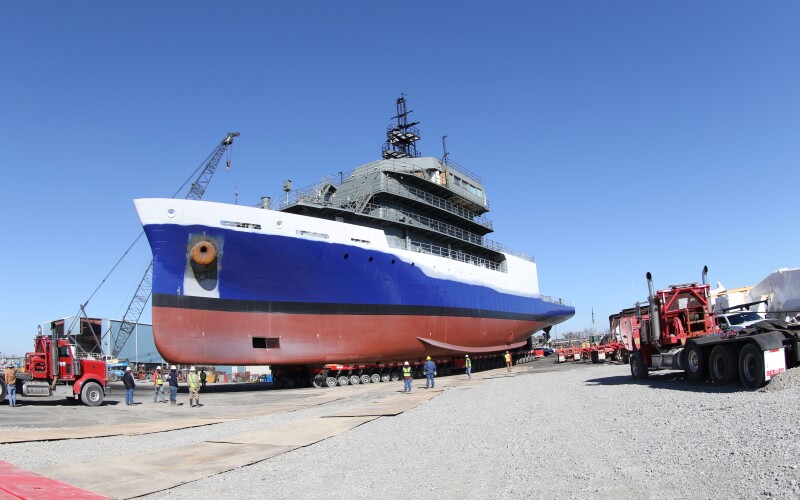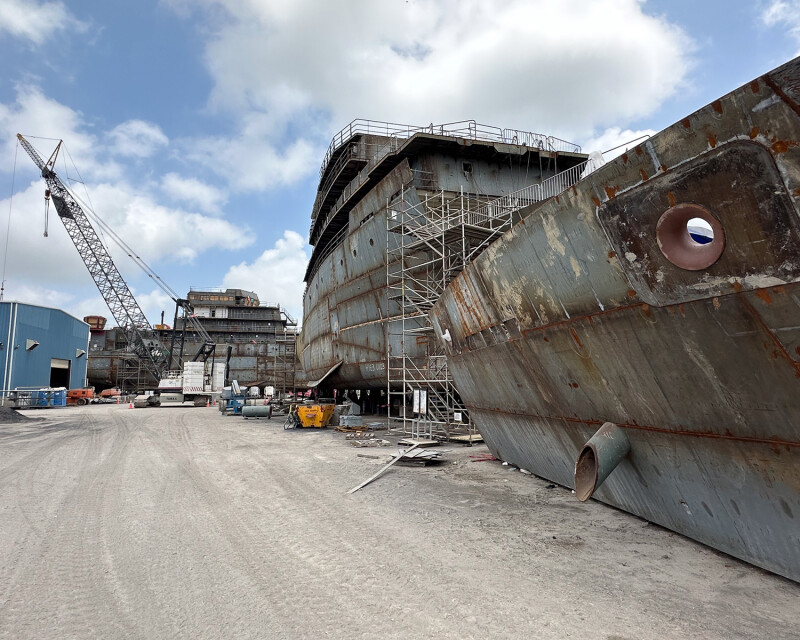America’s research vessel fleet is undergoing a once-in-a-generation renewal that could propel new discoveries and a greater understanding of the nation’s territorial waters.
Current projects include four deepwater ships under construction for the National Oceanic and Atmospheric Administration (NOAA), as well as three Regional Class Research Vessels (RCRVs) for the National Science Foundation. Multiple catamarans in various stages of development will support exploration of coastal and inland waterways.
Although the size, scope, and mission of these ships differ, the growing embrace of hybrid propulsion is a common theme. And while the systems vary, each promises new efficiencies and reduced fuel consumption and greenhouse gas emissions, among other benefits.
DEEPWATER RESEARCH SHIPS
The largest of these new ships are under construction at Thoma-Sea Marine Constructors in Houma, La., which is building the two classes of NOAA ships, each with hybrid propulsion. The 244'x51'x22' Oceanographer and Discoverer are both in the water and scheduled for delivery in 2026. Meanwhile, the shipyard cut steel on the 270'x50' Surveyor and Navigator this spring ahead of projected delivery in 2027 and 2028.
Oceanographer and Discoverer feature an efficient hull form developed by Thoma-Sea’s in-house team and its design agent Technology Associates, Inc, according to Walter Thomassie, the shipyard’s managing director. Four Cummins QSK 38 Tier 4 engines anchor the diesel-electric propulsion system featuring an integrated Siemens Energy BlueDrive PlusC platform with batteries that can store 712 kWh of electrical power. That propulsion system provides power to Schottel L-drives and a Tees White Gill pump jet bowthruster.
The hybrid platform on Oceanographer and Discoverer is projected to reduce fuel consumption by about 15,000 gallons per year, with the added benefit of reducing CO2 emissions by about 5,700 tons, according to NOAA.
“We are really excited about the design, because it was a different approach and we leveraged technologies we had been using for years in the commercial area,” Thomassie said. “It was challenged by the government and we had to prove it, so we are proud of the effort that went into putting that design together.”
The custom hybrid platform installed on Oceanographer and Discoverer emerged following extensive research into NOAA’s operating profile. It incorporated NOAA’s objectives, such as the ability to reduce noise while operating in sensitive areas and minimizing wear on the propulsion system.
“Our goal was, we want to get the most practical bang for the buck … and we put the system together that way,” Thomassie said.
“We found a solution to lower fuel consumption, extend range, balance peak loading without having to crank generators and give them a feature for entering sensitive ports under battery power,” he continued, while noting the ships are “not designed for open ocean transit using only batteries, other than for short periods of time.”
Oceanographer and Discoverer will operate from Honolulu and Newport, R.I., respectively, and perform oceanographic research on marine life, climate and ocean ecosystems, NOAA said. The vessels will join a NOAA fleet of roughly 15 ships that in 2023 averaged 30 years old.
The average age of the NOAA fleet will fall further with the delivery of Surveyor and Navigator, which will primarily perform charting and ocean mapping. These vessels, awarded to Thoma-Sea through a different contract, also will have a Siemens Energy BlueDrive PlusC hybrid propulsion platform with battery storage. Four Caterpillar 3512 Tier 4 engines will generate electricity for propulsion, research capabilities and hotel loads.
The yard’s experience with diesel-electric propulsion gained through building vessels for the offshore oil industry informed its approach to these larger NOAA ships, Thomassie said. The system, he explained, “finds the happy spot where all of these engines can be running at the most efficient speed to hit the power fuel curve where you are getting the most kW for this given load while using the least amount of fuel.”
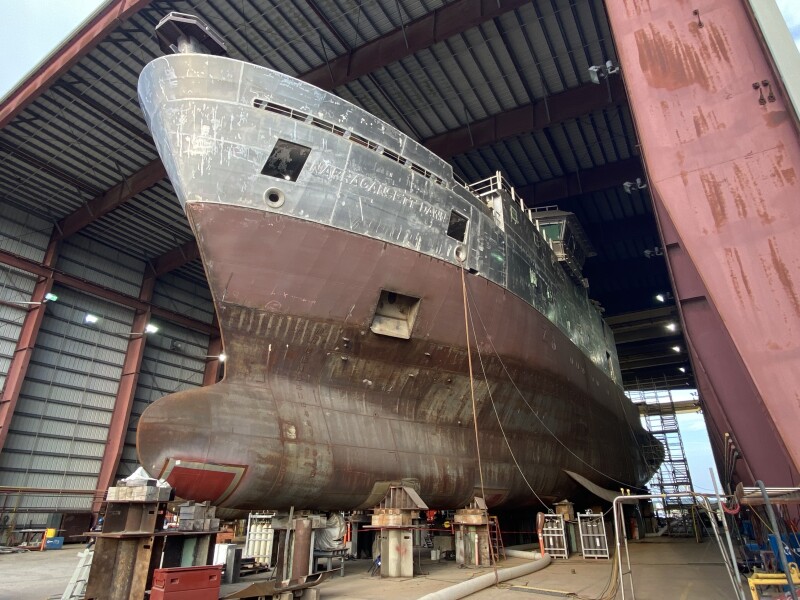
The three RCRVs developed through a National Science Foundation program also are edging closer to delivery from Bollinger Shipyards following a prolonged development cycle. Oregon State University (OSU) is overseeing the construction and transition to operations of the three 199¢6²x41¢ ships. Glosten Associates designed the vessels, which can spend up to three weeks at sea while transiting up to 5,400 nautical miles.
Taani, the lead ship, is expected to be delivered in early 2026 followed by a year of science and operational trials to “really put it through the paces,” said Clare Reimers, an OSU professor emerita supporting the project. It will operate from Newport, Ore. Two sister ships, Narragansett Dawn and Gilbert Mason, should deliver later in 2026 and operate from ports in Rhode Island, and Mississippi and Louisiana, respectively.
Each ship features a diesel-electric powerplant that delivers electricity for propulsion, research equipment and hotel loads through a Siemens Energy BlueDrive PlusC system. Three EPA Tier 4-rated Caterpillar C32 engines drive variable-speed Siemens Energy generators. Siemens Energy electric motors drive Schottel STP-1012 stern thrusters, a retractable Schottel SRP 170 propeller thruster and flush-mounted SPJ 82 azimuthing jet thruster.
“These are Z-drive vessels, so they are going to be very maneuverable, and they will be able to maintain dynamic positioning so you can precisely sample within the ocean, particularly at the seafloor,” Reimers said.
Key maritime components on ships absolutely loaded with them include a Kongsberg dynamic positioning system that meets ABS DP1 standards, two Rapp/MacGregor winches and MacGregor cranes, A-frames and a starboard-side robotic launch and recovery system for sensors and other devices, according to OSU. Kongsberg and Simrad provided research equipment while Beier Electronics supplied the integrated bridge system that includes Furuno navigation electronics.
COASTAL AND INLAND VESSELS
Multiple research ships that will operate along the nation’s coastal waters have entered service recently, and others are still under construction. Several such projects are currently underway at All American Marine.
Daniel Zech, business development manager for the Bellingham, Wash., shipyard, said customers have three primary objectives these days when it comes to building new research vessels. Functionality and versatility are often top of mind.
“Right now, it’s deck space with a large outdoor working area with the combination of overnight bunk accommodations,” he said in an interview. “That third component is fuel efficiency.”
“For a lot of these vessels, the core mission is to support their students,” Zech added, referring to vessels built for universities. “But they are also running these vessels as a business, so the efficiency of the hull makes for a much more appealing business case for people looking to rent the vessel.”
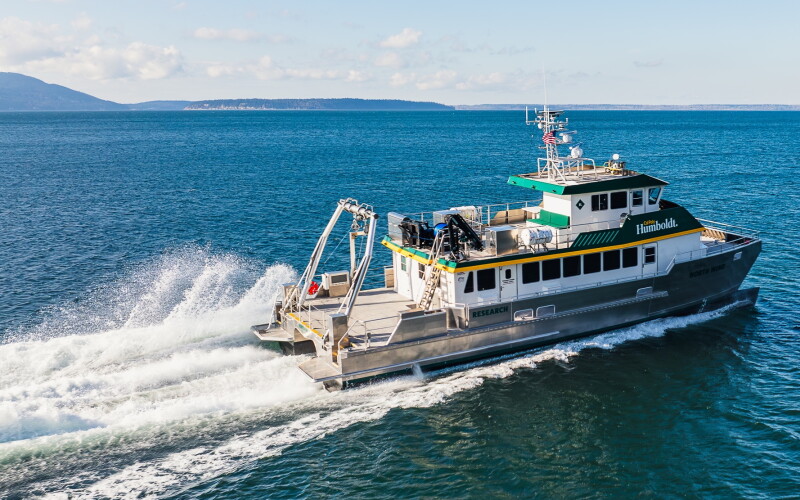
In February, All American delivered the 78'x26.7' aluminum catamaran North Wind to Cal Poly Humboldt in Arcata, Calif. The Teknicraft-designed semi-displacement hull cruises efficiently at 28 knots and has accommodations for 14 researchers and up to 40 daytime passengers.
This cleaner-running vessel is powered by twin 1,200-hp MAN Tier 4 engines equipped with diesel particulate filters to meet forthcoming California Air Resources Board (CARB) emissions regulations. Other components include Kongsberg scientific research electronics and Okeanus deck equipment.
All American has several other aluminum catamaran research vessel projects underway, all based upon Teknicraft designs. These include a 73' vessel for University of North Carolina Wilmington powered by Scania engines and a 63' hybrid catamaran for the Orange County Sanitation District. The hybrid platform will feature twin Cummins QSB 6.7 generators, BorgWarner batteries that can hold 588 kWh of charge and ABB electrical architecture.
Another hybrid research vessel has already entered service in the Pacific Northwest. Last year, Snow and Company shipyard in Seattle’s Ballard neighborhood delivered the 50'x16' plug-in hybrid catamaran Resilience for the Pacific Northwest National Laboratory (PNNL) in Sequim, Wash. It’s equipped with Volvo Penta D8 engines, Danfoss Editron electric motors and Spear Trident batteries that can store 113 kWh of electricity, according to PNNL. Resilience is also the first hybrid vessel in the U.S. Department of Energy fleet.
A first-of-its-kind hydrogen hybrid research vessel in development by the Scripps Institute of Oceanography at the University of California San Diego reached a key milestone last year. ABS gave approval to the preliminary design for the platform designed by Glosten. Current plans call for the ship to operate on zero-emission hydrogen fuel cells for 75% of its propulsion.
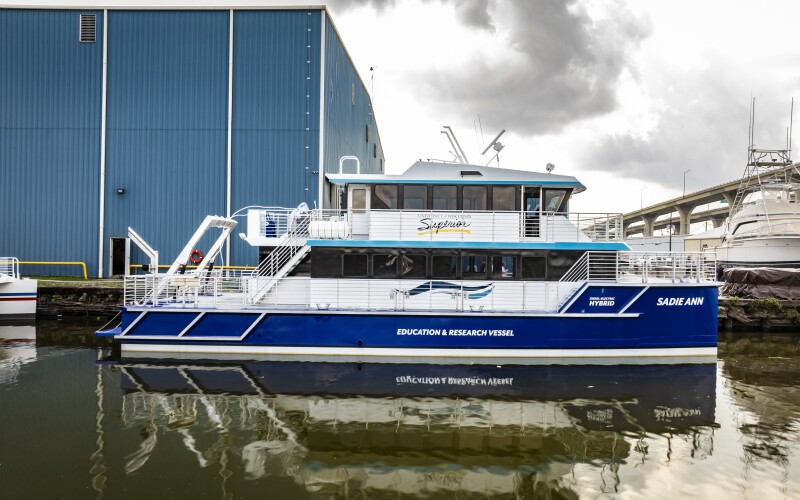
Further inland, the Lake Superior Research Institute at University of Wisconsin – Superior will soon take delivery of the 65'x24' hybrid catamaran Sadie Ann from Midship Marine in Harvey, La. Amy Eliot, the institute’s associate director, said Sadie Ann will replace the beloved, if antiquated, L.L. Smith Jr. for research on Lake Superior’s frigid waters. Sadie Ann can hold up to 49 passengers and reach 18 knots.
Incat Crowther designed Sadie Ann, which has a parallel hybrid system designed by Esco Power. The vessel is equipped with John Deere engines, Northern Lights generators, and Lehmann Marine COBRA batteries that store 86 kWh of charge.
Eliot estimates the hybrid propulsion system added about $1 million to construction costs that were largely funded by private donations. But she said those costs are worth it for the many operational and educational benefits the system offers.
“It was the reduced wear and tear on the engines, the potential for payback over the life of the vessel, learning opportunities for the campus,s and the quiet nature of the system and what that would mean for us for both research and educational missions,” Eliot said in a recent interview. “All of those things had a role for why we selected the hybrid system.”




